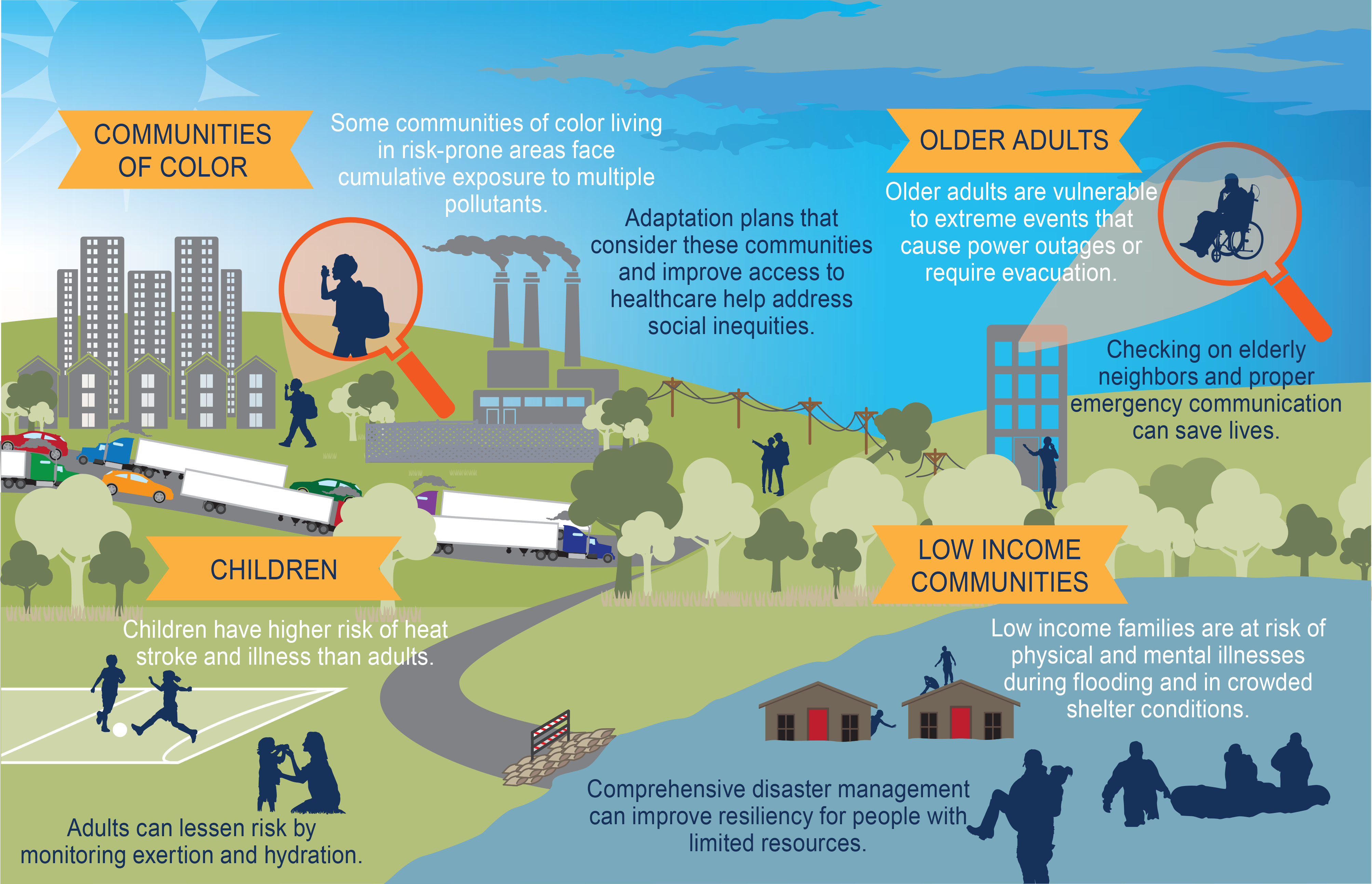Global Warming Affect Human Health

Global warming affects human health in a multitude of ways, directly and indirectly, through changes in temperature, weather patterns, air quality, and the distribution of diseases. Here’s a detailed look at how global warming impacts human health:
Direct Health Effects
-
Heat-Related Illnesses:
- Heatwaves: Increased frequency, duration, and intensity of heatwaves can lead to heat exhaustion, heatstroke, and dehydration. Vulnerable populations such as the elderly, children, and those with pre-existing health conditions are at higher risk.
- Cardiovascular and Respiratory Stress: High temperatures can exacerbate cardiovascular and respiratory conditions, increasing the risk of heart attacks, strokes, and respiratory distress.
-
Injuries and Deaths from Extreme Weather Events:
- Storms and Floods: More intense hurricanes, storms, and floods can cause injuries, fatalities, and significant psychological stress. These events also lead to displacement and loss of homes, exacerbating mental health issues.
- Wildfires: Higher temperatures and prolonged droughts increase the risk of wildfires, causing burns, smoke inhalation injuries, and long-term respiratory problems.
Indirect Health Effects
-
Vector-Borne Diseases:
- Expanded Range of Vectors: Warmer temperatures and changing precipitation patterns can expand the habitats of vectors such as mosquitoes and ticks. This can lead to increased incidence of diseases like malaria, dengue fever, Zika virus, and Lyme disease.
- Seasonal Changes: Changes in the length and intensity of seasons can affect the life cycles of vectors and the pathogens they carry, potentially increasing transmission periods.
-
Food and Water Security:
- Malnutrition: Climate change can disrupt food production, leading to reduced crop yields and higher food prices. This can result in food shortages and malnutrition, particularly in vulnerable regions.
- Water Quality and Availability: Changes in precipitation and increased temperatures can affect water supply and quality. Droughts can lead to water scarcity, while heavy rains and floods can contaminate water sources with pathogens and pollutants, leading to waterborne diseases.
-
Air Quality:
- Increased Air Pollution: Higher temperatures can increase the concentration of ground-level ozone, a harmful air pollutant. This can exacerbate respiratory conditions such as asthma and COPD.
- Allergens: Longer growing seasons and higher CO₂ levels can increase the production and distribution of allergens like pollen, worsening allergies and asthma.
Social and Psychological Impacts
-
Mental Health:
- Stress and Anxiety: The threat and impact of extreme weather events, displacement, and loss of livelihoods can lead to chronic stress, anxiety, and depression.
- Trauma: Survivors of natural disasters often experience post-traumatic stress disorder (PTSD) and other long-term psychological effects.
-
Displacement and Migration:
- Climate Refugees: Rising sea levels, extreme weather events, and deteriorating living conditions can force people to migrate. Displacement can disrupt communities and strain resources in receiving areas, leading to social and health challenges.
Vulnerable Populations
- Elderly and Children: These groups are more susceptible to the health impacts of heat, poor air quality, and infectious diseases due to their physiological characteristics and lower adaptive capacity.
- Low-Income Communities: People in low-income communities often have less access to healthcare, live in areas more vulnerable to climate impacts, and have fewer resources to adapt to changes.
- People with Pre-Existing Health Conditions: Individuals with chronic illnesses such as heart disease, respiratory conditions, and diabetes are more vulnerable to the exacerbated effects of climate change on health.
Mitigation and Adaptation Strategies
-
Public Health Infrastructure:
- Early Warning Systems: Implementing systems to warn populations about extreme weather events and heatwaves can help reduce health risks.
- Healthcare Access: Improving access to healthcare, particularly in vulnerable and underserved communities, is crucial for managing the health impacts of global warming.
-
Urban Planning:
- Green Spaces: Increasing urban green spaces can reduce the urban heat island effect, improve air quality, and enhance residents’ mental health.
- Resilient Infrastructure: Building infrastructure that can withstand extreme weather events can reduce injuries and fatalities.
-
Climate-Smart Agriculture:
- Sustainable Practices: Implementing sustainable agricultural practices can help ensure food security and reduce the impact of climate change on crop yields.
- Water Management: Efficient water use and management strategies can help secure water supplies and protect against waterborne diseases.
-
Education and Awareness:
- Public Education: Raising awareness about the health impacts of global warming and promoting adaptive behaviors, such as hydration during heatwaves and using mosquito nets in areas with vector-borne diseases, is essential.
By understanding and addressing the health impacts of global warming, societies can develop strategies to protect public health, improve resilience, and mitigate the adverse effects of climate change.
Thank you,